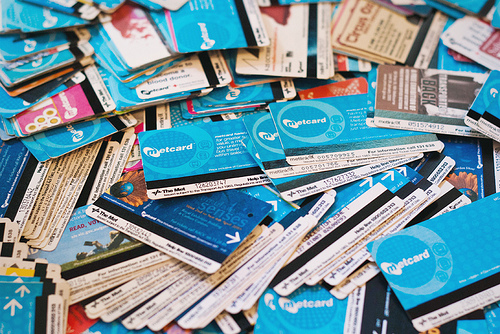Forget myki – I’m holding onto my Metcard
VICTORIA’s ambitious smartcard ticketing system, myki, promised efficiency and convenience. But as Marcella Purnama muses, it seems to have fallen short on both counts.
Last year, I took a vow to hold onto my Metcard for as long as I could. It has now been two months since the phasing out of weekly, monthly, and yearly Metcard sales. I’m currently one of 70 percent of commuters who are still holding onto our metcards – and I will be doing so for as long as I possibly can.
For me, the controversial $1.35 billion smartcard ticketing system has been disappointing, as throughout Melbourne you’ll find non-operating myki readers and long queues of frustrated commuters waiting to touch on and touch off.
While myki was first planned in 2003 as a smartcard technology that would provide “quicker, easier, and cheaper public transport”, I found myself traveling slower as commuters queued for one malfunctioning myki reader after another. It’s also been a common sight to see perplexed tourists and complaining travellers on a daily basis.
This all makes me wonder whether replacing our “disposable paper tickets” – in a bid to contribute better toward the environment among other things – is even worth the money, time, and effort.
The tipping point for me was when the Victorian Ombudsman found that the seemingly innocent , Singapore-like public transport ticketing system had cost at least $350 million more than originally budgeted.
So there goes my tax, along with another million obedient citizens’.
To top it off, last year alone, there were 2049 documented myki card malfunctions – definitely not a good move for myki to earn my trust.
And I’m not alone.Take these commuters who voiced out their complaints to the Herald Sun.
“With myki, hundreds of people are forced to queue up for one single not-working myki reader. Please dump this annoying ticketing system,” Victorian traveler Phong wrote.
Plus, as if they were reading my mind, others wondered why the government chose to replace the decades-old Metcard system in the first place.
“The government should have left the Metcard system alone. There was nothing wrong with it,” Frankston commuter Arthur said.
While technology should be getting more advanced rather than having glitches, myki has shown the total opposite. A friend of mine, Ivan, told me that he is particularly distressed when trying to add credit to the cards.
“If I touch on on a tram and then the reader says that my myki credit hasn’t been topped up, then what should I do? Should I go to the myki vending machine somewhere and pay for the second time?” he asks.
Of course, I’m biased, and another friend of mine actually has a different opinion, saying that they are of similar systems.
“I think myki is more convenient, as you can easily recharge your myki,” he says.
“But, overall, I don’t see much difference between myki and Metcard.”
Years in the pipelines
Call me a skeptic, but you only need to look at this history of myki to understand where I’m coming from.
In 2003, the Labor Party formed the Transport Ticketing Authority (TTA) – a body whose job was to oversee Victoria’s current Metcard system and manage the new myki system as well. Back then, TTA chief executive Bernie Carolan said myki offered the “best possible fare” guarantee as it included automatic calculation of the cheapest fare.
In 2005, then Premier Steve Bracks and treasurer John Brumby promised myki would be fully operational by 2007. A promise, which would not be fulfilled until five years later.
A contract was then signed with Melbourne-based foreign company Kamco, whose job was to construct the $1billon Myki system.
As Premier Bracks resigned in 2007, treasurer John Brumby then took his place and myki’s first trial on buses was completed. However, myki’s trial runs on metro trains were not completed until 2009.
In 2010, three years after the promised fully operational public transport system, myki had finally been installed in buses and trams. But in July, even Ted Baillieu, who was in opposition at that time, referred to myki as “the most useless piece of plastic in Australia” – an opinion he seemed to change when he was eventually elected as Premier.
So you see, even nine years and three Premiers after plans for its implementation were first announced, myki, in my opinion, has yet to see its first signs of success.
Perhaps RMIT’s Paul Mees said it best when he wrote his opinion piece in 2010, agreeing the system should be scrapped.
“The most popular [view] is that cancelling the project would mean the $700 million spent to date would be wasted,” he wrote.
“This is correct, but continuing with the project will waste a further $650 million over the coming years.
“Throwing good money after bad is usually a dumb idea.”
Criticisms fall on deaf ears?
To my utter disbelief, in June 2011 the new state government decided to keep myki, saying that $1 billion more of the taxpayer money would be needed to scrap the system.
So what has the Baillieu government promised then? Eliminating short-term cards, not including V/Line intercity and long distance coach services until the Myki system is proven reliable, and not installing Myki vending machines on trams. Not many benefits for the commuters, if I may say so myself.
And clearly, constant delays, budget blowouts, and malfunctioning systems are a pretty clear reflection of the government’s ability to deliver on its promises as far as this is concerned.
But what is there to do? Myki and Metcard systems will still be operating hand in hand until the end of this year.
By then, the forced migration of Melbourne public transport users on to the new smartcard system will be complete.
Are you happy about the switch to myki? Tell us below.


